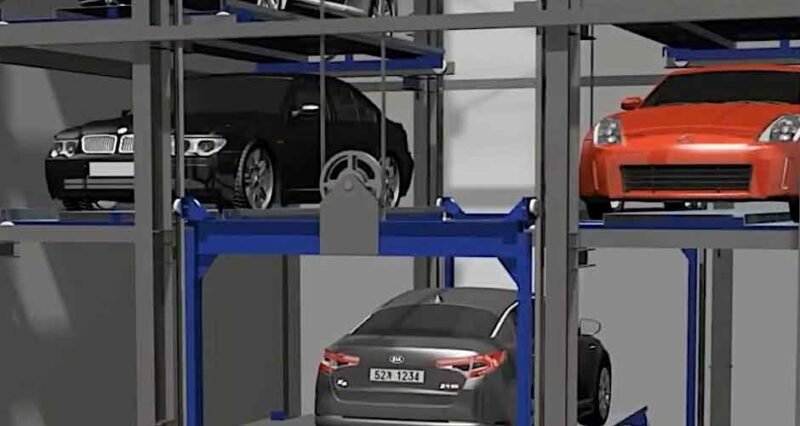
In the ever-evolving landscape of urban living, finding space for parking has become an increasingly complex challenge. Enter vertical parking systems, a modern solution to the age-old problem of parking scarcity. This comprehensive guide discusses car stackers, exploring their benefits, various types, intricate working mechanisms, and essential considerations for successful implementation.
Understanding Vertical Parking Systems
At its core, a vertical parking system is a mechanical marvel designed to stack and store vehicles in a vertical arrangement efficiently. As urban spaces continue to shrink and the number of cars on the road swells, these innovative systems offer a practical and innovative way to address the parking crisis. These systems present an elegant solution by maximizing space usage and effectively stacking vehicles, allowing multiple cars to occupy the same footprint that would traditionally house just one.
Benefits of Vertical Parking Systems
Space Optimization
One of the most striking advantages of vertical parking systems is their knack for optimizing space. By ingeniously utilizing horizontal and vertical dimensions, they are tailor-made for cramped locations such as narrow streets or the corners of buildings. This efficient use of space is a boon for crowded urban areas where every square meter counts.
Increased Capacity
Vertical parking systems hold the power to dramatically augment a given area’s parking capacity. In a world where parking real estate is in short supply, this advantage cannot be overstated. These systems make it possible to park more vehicles in the same space, providing a practical solution to the growing demand for parking.
Reduced Environmental Impact
As the world pivots towards sustainable practices, vertical parking systems offer a greener approach. By requiring significantly less land compared to traditional parking lots, these systems contribute to preserving green spaces while simultaneously reducing the carbon footprint associated with expansive parking areas.
Enhanced Security
The realm of vertical parking systems often comes with advanced security features. Access control mechanisms and surveillance technologies are integrated to provide a secure environment for parked vehicles. This added layer of protection is valuable in urban areas where vehicle theft and vandalism are prevalent concerns.
Types of Vertical Parking Systems
Puzzle Parking Systems
Picture a puzzle coming to life in the form of a parking solution. Puzzle parking systems ingeniously utilize horizontal and vertical movements to slot vehicles into place. These systems resemble intricate puzzles, with cars arranged in a matrix-like structure. Each piece of the puzzle, or in this case, each vehicle, fits perfectly into its designated slot.
Tower Parking Systems
Tower parking systems introduce a vertical tower into the equation. The tower houses rotating platforms that serve as parking spots. As a car is driven onto a platform, the tower gracefully rotates, bringing the chosen vehicle down to the ground level for retrieval. This efficient design eliminates the need for lengthy aisles, making it a space-savvy choice.
Shuttle Parking Systems
Shuttle parking systems introduce an element of dynamic movement. Cars are parked on a platform known as a shuttle, which moves horizontally and vertically within the parking structure. The shuttle effortlessly transports the vehicle to its designated parking spot, ensuring efficient use of space and time.
How Vertical Parking Systems Work
The inner workings of vertical parking systems are a blend of mechanical precision and intelligent engineering. As a vehicle is driven onto a designated platform, the magic begins. Hydraulic lifts, conveyor belts, and mechanical arms orchestrate a seamless vertical ascent, slotting the car into its predetermined parking space. When the owner wishes to retrieve their vehicle, the process is reversed. The platform descends to ground level, granting easy access to the awaiting driver.
Considerations for Implementing Vertical Parking Systems
Space Requirements
While vertical parking systems are celebrated for their space-saving capabilities, they still demand a certain amount of room for installation. Adequate space must be allocated not only for the mechanical components but also for the necessary vertical clearance required for stacking vehicles.
Maintenance and Repairs
The longevity of vertical parking systems hinges on regular maintenance. Establishing a comprehensive maintenance plan is imperative to ensure these systems work smoothly. Routine check-ups and swift repairs are the cornerstones of sustained functionality.
Cost Analysis
Implementing vertical parking systems necessitates a financial investment. While the initial costs may appear higher compared to conventional parking solutions, the long-term benefits can outweigh these expenses. Expanding parking capacity and potential income can result in a positive ROI.
User Experience
The success of any technological implementation lies in user experience. Clear and concise instructions for users, user-friendly interfaces, and hassle-free vehicle retrieval mechanisms are paramount. Addressing potential technical glitches and providing swift solutions enhance user satisfaction.
Car stackers, often referred to as vertical parking systems, stand as a testament to human ingenuity in the face of urban challenges. These systems effectively address parking scarcity while presenting a range of benefits, including optimized space usage, increased capacity, reduced environmental impact, and heightened security. As cities continue to grow and parking demands surge, vertical parking systems provide a practical and progressive solution, streamlining urban mobility while efficiently utilizing space.

